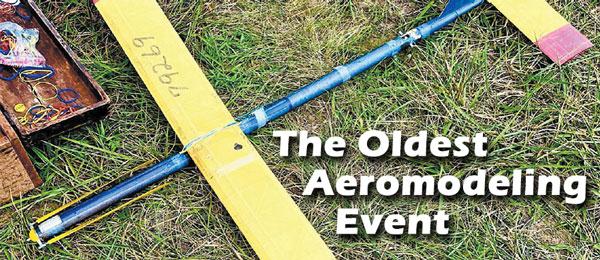By Louis Joyner | [email protected] As seen in the June 2022 issue of Model Aviation.
Image

President David Lindley. The trophy is on permanent display in the AMA National Model Aviation Museum in Muncie IN. Gerald Brown’s name will be added to the other names on the Mulvihill trophy, which is held by NFFS President David Lindley. The trophy is on permanent display in the AMA National Model Aviation Museum in Muncie IN. 2023 WILL MARK the 100th anniversary of the Mulvihill Rubber event and the 95th anniversary for the international Wakefield Cup. Both events are for rubber-powered Free Flight (FF) models, but the rules are quite different. Wakefield rules have evolved throughout the years, with a steady reduction in motor weight and other restrictions intended to reduce performance. (Performance has actually increased with improved aerodynamics, auto surfaces, and extensive use of carbon fiber.) The Mulvihill trophy was donated by World War I aviator Bernard Mulvihill Sr. The trophy depicts the mythical Icarus strapping on his wings before his flight that was too close to the sun. The wax holding the feather wings to his arms melted and he fell into the sea. The Mulvihill rules have stayed the same for many years. Actually, there is only one rule: The maximum wing area is 300 sq. in. It is the flying format that makes Mulvihill one of the toughest events in FF. Instead of Wakefield’s seven rounds and a flyoff, Mulvihills must fly a series of flights with the max increasing 1 minute for each flight. For a Category Two field, such as the International Aeromodeling Center in Muncie, Indiana, the first flight is a 2-minute max, the second is 3 minutes, and so on. If you miss a max, you are done for the day. I asked 2019 winner Dan Berry to talk about his win and his thoughts about the event. "I flew Bud Romak’s Dominator design when I won in 2019," he said. "Marvin Mace once told me, ‘You’re flying against yourself.’ Norm Poti said, ‘As long you don’t drop, you’re not behind.’" (The Dominator plans are available from the National Free Flight Society [NFFS].)
Image

Caleb Finn won first place in Junior Mulvihill and Junior P-30 with the Echo P-30. The design, by Ken Grubbs, offers a good introduction to competitive FF. Dan continued, "I flew, knowing it would be a retrieval event, as it was quite windy. The wind kept a lot of planes in cars and I got lucky and won. I had four maxes and watched the scoreboard the rest of the day. "I didn’t figure anyone was going to catch me, but I got to the point of wanting to win it. My 5-minute max went nearly as far as the golf course but not into a tree. A 6-minute flight would have been an adventure. I was willing to do it but only if necessary. I was watching the board for sure. Four maxes won." Gerald Brown was the 2021 winner. "If you have a well-adjusted model, all you need to do is pick good air," he said. "I flew the 2-minute and 3-minute flights in the morning, flew Power, then flew the 4- and 5-minute flights in the afternoon." Gerald had flown the event six or seven times before winning. His best previous placing was third. The model he used in 2021 was the Tube Stake that was designed by Jim O’Reilly. "It’s a good thermal model," he noted. There are several versions of the Tube Stake. The original one has a larger wing with slightly less than 300 sq. in. of wing area. The Tube Stake III that Gerald used is smaller, with a wing area of 251 sq. in. Both use a rolled balsa motor tube and tapered balsa tailboom. The wing and stabilizer use a modified Union Jack construction. Full-size plans or a short kit are available from Bob Holman Plans. (Jim O’Reilly has retired from the plans business and has passed his plans to Bob.) The Mulvihill trophy event is open to all age groups, and individual trophies (but not the trophy) are awarded in the Junior, Senior, and Adult categories. The flier with the highest time overall gets his or her name engraved on the Mulvihill trophy. In 2021, young Caleb Finn was the Junior winner with a total time of 439 seconds and that was 11th overall. He was flying a beginner P-30 that was designed by Ken Grubbs. The Echo P-30 is kitted by Caleb’s mom and dad at J&H Aerospace. Caleb also won Junior P-30 the next day, flying the same model. The winning Senior was Hailey Mattson. If you want to compete with Dan and Gerald in 2022, what should you build? In addition to the Dominator that Dan used, the Tube Stake has proven to be a winner for Jim O’Reilly and Chuck Markos, as well as Gerald. The late Bill Shailor’s Bouda won the Mulvihill for Bill and twice for his son, John. See "Sources" for plans and short kits.
Image

Gerald’s 2021 Mulvihill winner is a Jim O’Reillydesigned Tube Stake. The motor tube and tailboom are rolled balsa, while the front end is from Igor Vivchar in Ukraine. You could also design and build a Mulvihill from scratch. At first glance, building a model with the maximum wing area of 300 sq. in. seems like a logical plan. The larger size might help with visibility on a long, downwind flight. A larger airframe, however, could end up heavier and require a bigger motor. (There are no restrictions on rubber weight.) In the 2007 Free Flight Forum, the late Peter King addressed the optimum size for a Rubber model with a 50-gram maximum motor weight. (The British Model Flying Association flies an Open Rubber event that has different rules than our Mulvihill event.) The result of Peter’s computer simulations of a variety of model sizes could offer some guidance for our event. Peter ran simulations for two models: one with a wing area of 230 sq. in. and an airframe weight of 70 grams, and a slightly larger model with a 300 sq. in. wing area and an airframe weight of 82 grams. Altitude for the smaller model was 349 feet, with a motor run of 108 seconds. The larger model’s altitude was 295 feet, with a motor run of 125 seconds. The duration estimations were nearly identical at 383 seconds and 380 seconds. Peter also simulated what he called a "Super 50-gram F1B." It is basically a standard F1B Wakefield with a 50-gram motor instead of the 30-gram motor used for Wakefield. Even with the much higher airframe weight of 190 grams, the Super Wakefield out-performed the other models that he simulated. Motor run times were much shorter at 47 seconds and 67 seconds for a version with a larger-diameter propeller and fewer strands of rubber. The climb height for the two versions were close: 429 feet for the first version and 436 feet for the second version. Calculated durations were 443 seconds and 470 seconds, respectively. Although the total flying weight for the Super Wakefield was nearly 100 grams more than the other models that he simulated, the superior efficiency of the F1B made a significant difference in both climb and glide performance. Variable-pitch propellers, higher-aspect-ratio wings, auto stabilizers and rudders, and wing-wigglers are not forbidden under Mulvihill rules. In fact, the Mulvihill rules only mention the maximum wing area and that the model must be rubber powered. SOURCES:
NFFS
www.freeflight.org
www.freeflight.org
J&H Aerospace
www.jhaerospace.com
www.jhaerospace.com










Comments
Wakefield
The first Wakefield was flown in 1911. I can't get that to come out to 95 years ago.
https://www.endlesslift.com/wakefield-challenge-cup-competition-centenn…
Add new comment